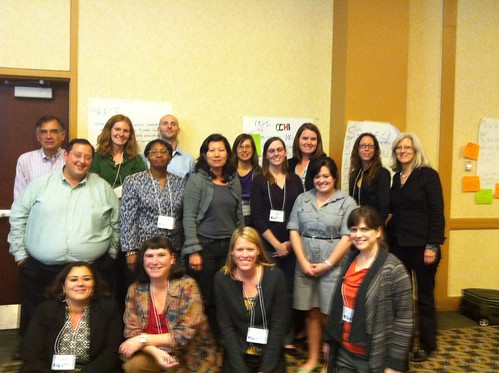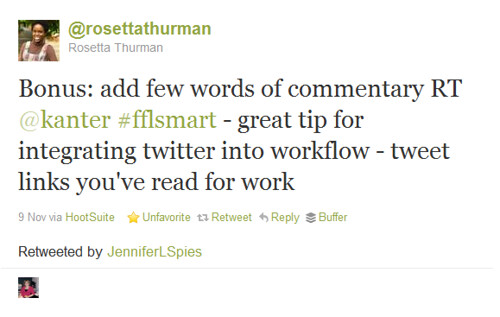
As part of my work this year as Visiting Scholar at the Packard Foundation, I’ve had the pleasure of working on a social media capacity building project with Liane Wong, Program Officer, grantees of in the “Insuring America’s Children: Getting to the Finish Line” and Ed Walz, and all the good folks at SpitFire Strategies. We have designed and been delivering “Friending the Finish Line” with the goals of having organizations create an integrated social media strategy into their overall communications plan and as a way to accelerate the progress of their children’s health care advocacy work and create a peer networked learning community. The project includes face-to-face training, webinar, as well as one-on-one coaching provided by the expert team at SpitFire.
This blog post is a roundup of the face-to-face we had last week in Houston to share some of the amazing lessons learned and some reflections. We got started with a welcome from Liane Wong who gave an overview of the program and how it fits into the grantmaking strategy that uses a networked approach. Along with Ed Walz, myself, and Liane, we spent a lot of time at the beginning mapping out program level outs and used a modified theory of change process. This prevents getting to tactical too quickly and places results in a larger context. It also connects the social media technical assistance to results.
We started with key results and worked backwards to technical assistance goals:
- Kids get health care coverage Policies are adopted More attention from policymakers
- More and better partners, more and better relationships with reporters and more or better policy maker relationships
- Organizations’ communications strategies have more impact individually and collectively
- Grantees get better at communication, proactive planning, partner engagement, message discipline and social media integration and measurement
- Grantees get better results integrating Facebook, Twitter, and other social media channels best practices and measurement.
This was designed as a peer learning activity – so it was the participants who were mostly the presenters. My role was to facilitate and model new practices and present on a couple of new approaches, such as content curation. We established a hashtag for the event #fflsmart and modeled how you can capture a complete archive with rowfeeder and since content curation was on the agenda, I modeled using storify to capture a curated record of the event. When you are building ties between nodes in a network or connections between peers, you need to build in networking time. So, we kicked things off with speed dating – modified share pairs to give participants swap success stories and mutual problem solving. I also added a round of “Pair Squares” or having two sets of pairs pair up – this helps break the intensity of the one-on-one. Content Curation Primer
I presented an overview on content curation why important, a framework, and introduced some new curation tools – scoop.it and storify. I realized that from participants reflections and questions that they’re already curating content – especially as policy analysts, but may not be integrating and sharing through social media channels. So, for these organizations, their content pyramid also includes integrating offline w/online channels.
Next Bruce Lesley gave a virtuoso case study of how he uses Twitter to curate news articles and resources related to children’s issues. He tweets from his own personal account and there is also an organizational Twitter account, but explained the benefits of tweeting as the CEO of the organization. It makes it easy for him to connect with influencers in the children’s issues field which builds the organization’s network. He has to track news articles and resources related to children’s issues, but diving into the stream, cherry picking the best, and sharing with his network he is building trust with his networks which includes journalists who consider he a source.
Bruce’s daily routine includes using an RSS reader/dashboard filled with the best blogs and keyword searches. He sits down for coffee and reads on his iPad using Flipboard making it easy to share. Bruce’s secret: be organized and know your sources. For example, he has meticulously organized his Twitter lists by issues and types. (If you’ve been a Twitter slob, you can quickly and easily organize your followers into lists using TweetBeat, ManageFlitter, or Forumulists.)
Participants were concerned about lack of time and the next presentation shared how to get started with small steps. But because this group of organizations is working in a networked way, it means that not everyone has to do content curation at the degree as Bruce. In fact, they could follow his curation and pick items from that, thus saving time. And, following great curators in your topic area is a best practice as noted by Robin Good and part of distinguishes great curators.
Bruce is now curating on Scoop.it – and has set up collections for children’s issues and also quickly identified other curators in those topics.
California Public Policy Director Judy Darnell offered a case study how she got started simply on Twitter. Her practical tips — like “start by tweeting one or articles you read at work in the morning. We all do a little work related reading in the morning, why not share that?” She typically “fits in” twitter during down time during the day, tweets from her mobile phone. She finds tweeting much easier than blogging and admits that she isn’t afraid to experiment. She encouraged the group that they could started tweeting five or ten minutes a day. (Here’s step-by-step process that you can use over 6-8 weeks to establish good practice)
What happened next was wonderful.

The participants, a number of whom were new to Twitter, starting asking a lot of how to questions. I improvised a peer share pairing people in small groups so that every group had someone new to Twitter and someone with a lot of expertise. During the debrief, we set up poster pages and had people add their tips, questions, and suggestions. These were transcribed and added to the wiki — and now have participants working on incorporating Twitter into the mix. Two gems shared by a participant was this leader board of healthcare tags and this twitter tool that lets you look up your legislator’s Twitter handle by zip code.
Integrated Social Media Strategy
We were luck to have Donna Norton from Momsrising share a presentation about their approach to integrated social media campaigns and success stories using a planning technique called “Layer Cake Strategy.” The exercise used the layer cake metaphor and some planning questions.
- Stories: How will encourage people to share their stories and capture them?
- Mixed-Media Engagement: How will you traditional media, social media, email, mobile, and other channels?
- On the Ground Engagement: What will you ask people to do offline?
- Member Voice Proxy: How will you make it memorable? How will you get their voice?
- One-Click Advocacy: What is the call to action online?
- Synergistic Collaboration: Who are you aligned partners online/offline?
SMART(er) Social Objectives
After lunch, I wanted an activity that included some movement. It is very important because this is when the energy level is at its lowest point in a training. Since participants are all working on integrated plans based on SMART objectives champion by the Spitfire Strategies (see their Smart Chart), we had them write their SMART objectives on posters and then review each other’s posters and provide feedback. (SMART objectives stands for “Specific, measurable, attainable, relevant, and timely” and I’ve been using it to help nonprofits formulate SMART objectives.) The point was to create “SMARTer” objectives. The “E” stands for evaluator and the “R” stands for “Revaluate.” As part of the “gallery walk,” we walked around the room as a group and debriefed. This helps to make connections.
Learning and Metrics
Next up was Ashley Boyd from Momsrising who gave a fantastic presentation on what metrics Momsrising uses to track their progress – not only KPIs but some of the countring metrics. Ashley is definitely a curator of metrics. What I liked best was the point Ashley about how they use qualitative feedback from members – they listen, but when their metrics tell them something is not working – they use the qualitative data (comments people leave on Facebook or blogs or the general email account) to get more insight. I’m going to devote a whole blog post this presentation because it was so rich, so stay tuned.
The next segment was a presentation and discussion about the process and value of establishing a social media policy from Sara Eskrich Wisconsin Council on Children and Families. They used the social media online policy to generate their first draft, but found the language was too “lawyer like” versus encouraging. They revised the language to fit their organizational style. Sarah notes that a policy is critical to internal buy in and doesn’t take that long to create.
One of the benefits of working in a networked way is that it is more efficient – especially if organizations can share and leverage each other’s content. Bruce Lesley lead a session on the Children’s Issues editorial calendar. This was exciting because the discussion leads to some opportunities to use synergistic collaboration through social media – and another example of how peer learning in a networked context can lead to collective actions.
